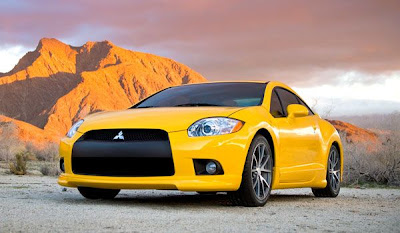The 2011 Mitsubishi compact Outlander Sport SUV/crossover isn’t as racy as it looks with its so-so four-cylinder engine. But it has decent prices, handy size, many features and good fuel economy.
The five-passenger Outlander Sport is more of a crossover vehicle than an SUV. It’s based on Mitsubishi’s larger seven-passenger Outlander SUV. But it doesn’t have its big brother’s third-row seat and is more than a foot shorter with chopped front and rear overhangs, although it’s much closer in width and height. Wheelbase is the same at 105.1 inches, but the Outlander Sport is lighter feels sportier. The base version with an automatic transmission only weighs 3,098 pounds, which makes the Outlander Sport among the lightest in its class.
This new Mitsubishi has distinctive, chiseled aerodynamic bodywork and an aggressive looking “shark nose” front end from the Lancer Evolution high-performance sports sedan.
While five passengers fit, the center of the rear seat is too stiff to allow comfortable seating for more than four. There’s plenty of room up front in supportive seats, but back-seat room is average for long-legged occupants.
The cargo floor is rather high for really fast loading or unloading at, say, airports. But there’s decent cargo space, and rear seatbacks flip forward and sit flat to allow considerably more room for loads.
The Outlander Sport is offered in two trim levels. There’s the entry level ES, which costs $18,495 with front-drive and a decent five-speed manual transmission. The ES lists at $19,495 with a responsive continuously variable automatic transmission (CVT), which has easily used magnesium-alloy shift paddles behind the steering wheel.
Standard for the ES are air conditioning, remote keyless entry, four-speaker sound system, cruise control, tilt/telescopic wheel, power windows and side mirrors and steering wheel audio controls.
Safety features include driver knee air bag, front side-impact air bags and curtain side air bags with roll-over sensors. The anti-lock brakes have electronic brake force distribution for surer panic stops.
Noteworthy is a brake override system that slows the vehicle to a stop if the accelerator and brake pedal are engaged simultaneously.
There also are stability control and traction control systems to help keep the Outlander Sport on the road during dicey situations.
The higher-line SE version costs $21,695 with front-drive and the CVT and $22,995 with that transmission and four-wheel drive. It adds a push-button start, automatic climate control and six speakers—besides wider tires on 18-inch (versus 16-inch) alloy wheels, powerful HID headlights that cast light over a wider path and heated front seats for the four-wheel-drive version. It also has upgraded interior fabric and a front seat center armrest.
Option packages contain a panoramic glass roof, 9-speaker sound system, rear spoiler and a navigation system with a rearview camera.
The Outlander Sport’s quiet interior looks fairly good and has has driver-friendly gauges and controls. However, small digital readouts, instead of gauges, for engine temperature and the fuel level don’t add to a sporty look. Front door pockets have bottle holders, and there are a fair number of interior storage areas and conveniently located front console cupholders.
The five-passenger Outlander Sport is more of a crossover vehicle than an SUV. It’s based on Mitsubishi’s larger seven-passenger Outlander SUV. But it doesn’t have its big brother’s third-row seat and is more than a foot shorter with chopped front and rear overhangs, although it’s much closer in width and height. Wheelbase is the same at 105.1 inches, but the Outlander Sport is lighter feels sportier. The base version with an automatic transmission only weighs 3,098 pounds, which makes the Outlander Sport among the lightest in its class.
This new Mitsubishi has distinctive, chiseled aerodynamic bodywork and an aggressive looking “shark nose” front end from the Lancer Evolution high-performance sports sedan.
While five passengers fit, the center of the rear seat is too stiff to allow comfortable seating for more than four. There’s plenty of room up front in supportive seats, but back-seat room is average for long-legged occupants.
The cargo floor is rather high for really fast loading or unloading at, say, airports. But there’s decent cargo space, and rear seatbacks flip forward and sit flat to allow considerably more room for loads.
The Outlander Sport is offered in two trim levels. There’s the entry level ES, which costs $18,495 with front-drive and a decent five-speed manual transmission. The ES lists at $19,495 with a responsive continuously variable automatic transmission (CVT), which has easily used magnesium-alloy shift paddles behind the steering wheel.
Standard for the ES are air conditioning, remote keyless entry, four-speaker sound system, cruise control, tilt/telescopic wheel, power windows and side mirrors and steering wheel audio controls.
Safety features include driver knee air bag, front side-impact air bags and curtain side air bags with roll-over sensors. The anti-lock brakes have electronic brake force distribution for surer panic stops.
Noteworthy is a brake override system that slows the vehicle to a stop if the accelerator and brake pedal are engaged simultaneously.
There also are stability control and traction control systems to help keep the Outlander Sport on the road during dicey situations.
The higher-line SE version costs $21,695 with front-drive and the CVT and $22,995 with that transmission and four-wheel drive. It adds a push-button start, automatic climate control and six speakers—besides wider tires on 18-inch (versus 16-inch) alloy wheels, powerful HID headlights that cast light over a wider path and heated front seats for the four-wheel-drive version. It also has upgraded interior fabric and a front seat center armrest.
Option packages contain a panoramic glass roof, 9-speaker sound system, rear spoiler and a navigation system with a rearview camera.
The Outlander Sport’s quiet interior looks fairly good and has has driver-friendly gauges and controls. However, small digital readouts, instead of gauges, for engine temperature and the fuel level don’t add to a sporty look. Front door pockets have bottle holders, and there are a fair number of interior storage areas and conveniently located front console cupholders.





No comments:
Post a Comment